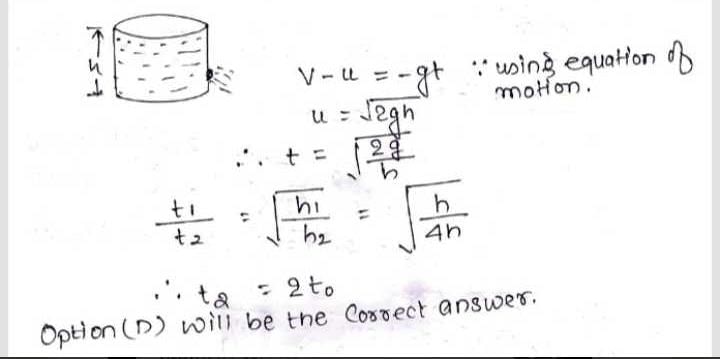Class 11 Exam > Class 11 Questions > A cylindrical vessel filled with water upto t...
Start Learning for Free
A cylindrical vessel filled with water upto the height H becomes empty in time t0 due to a small hole at the bottom of the vessel. If water is filled to a height 4H it will flow out in time
- a)t0
- b)4t0
- c)8t0
- d)2t0
Correct answer is option 'D'. Can you explain this answer?
Most Upvoted Answer
A cylindrical vessel filled with water upto the height H becomes empty...

Free Test
FREE
| Start Free Test |
Community Answer
A cylindrical vessel filled with water upto the height H becomes empty...
Explanation:
The time taken for a cylindrical vessel filled with water up to the height H becomes empty in time t0 due to a small hole at the bottom of the vessel is given by the Torricelli's law as:
t0 = (2πr²H)/A
where,
r = radius of the vessel
A = area of the hole
Now, if the water is filled to a height 4H, the time taken for it to flow out can be calculated as follows:
Let the height of the water column at any time t be h.
Therefore, the volume of water flowing out per unit time is given by the Torricelli's law as:
V/t = A√(2gh)
where,
V = volume of water in the vessel
t = time taken for the water to flow out
g = acceleration due to gravity
At the initial time t=0, h=4H and the volume of water in the vessel is V = πr²(4H) = 4πr²H
Substituting the values, we get:
V/t = A√(8gH)
Now, at any other time t, the height of the water column will be given by:
h = 4H - (gt²)/2
Substituting this value in the above equation, we get:
V/t = A√(8g(4H - (gt²)/2))
Squaring both sides and simplifying, we get:
t² = (16H)/g
or, t = 4√(H/g)
Therefore, the time taken for the water to flow out when the vessel is filled to a height 4H is 4 times the time taken for it to flow out when the vessel is filled to a height H. Hence, the correct option is D) 2t0.
The time taken for a cylindrical vessel filled with water up to the height H becomes empty in time t0 due to a small hole at the bottom of the vessel is given by the Torricelli's law as:
t0 = (2πr²H)/A
where,
r = radius of the vessel
A = area of the hole
Now, if the water is filled to a height 4H, the time taken for it to flow out can be calculated as follows:
Let the height of the water column at any time t be h.
Therefore, the volume of water flowing out per unit time is given by the Torricelli's law as:
V/t = A√(2gh)
where,
V = volume of water in the vessel
t = time taken for the water to flow out
g = acceleration due to gravity
At the initial time t=0, h=4H and the volume of water in the vessel is V = πr²(4H) = 4πr²H
Substituting the values, we get:
V/t = A√(8gH)
Now, at any other time t, the height of the water column will be given by:
h = 4H - (gt²)/2
Substituting this value in the above equation, we get:
V/t = A√(8g(4H - (gt²)/2))
Squaring both sides and simplifying, we get:
t² = (16H)/g
or, t = 4√(H/g)
Therefore, the time taken for the water to flow out when the vessel is filled to a height 4H is 4 times the time taken for it to flow out when the vessel is filled to a height H. Hence, the correct option is D) 2t0.

|
Explore Courses for Class 11 exam
|

|
Question Description
A cylindrical vessel filled with water upto the height H becomes empty in time t0due to a small hole at the bottom of the vessel. If water is filled to a height 4H it will flow out in timea)t0b)4t0c)8t0d)2t0Correct answer is option 'D'. Can you explain this answer? for Class 11 2025 is part of Class 11 preparation. The Question and answers have been prepared according to the Class 11 exam syllabus. Information about A cylindrical vessel filled with water upto the height H becomes empty in time t0due to a small hole at the bottom of the vessel. If water is filled to a height 4H it will flow out in timea)t0b)4t0c)8t0d)2t0Correct answer is option 'D'. Can you explain this answer? covers all topics & solutions for Class 11 2025 Exam. Find important definitions, questions, meanings, examples, exercises and tests below for A cylindrical vessel filled with water upto the height H becomes empty in time t0due to a small hole at the bottom of the vessel. If water is filled to a height 4H it will flow out in timea)t0b)4t0c)8t0d)2t0Correct answer is option 'D'. Can you explain this answer?.
A cylindrical vessel filled with water upto the height H becomes empty in time t0due to a small hole at the bottom of the vessel. If water is filled to a height 4H it will flow out in timea)t0b)4t0c)8t0d)2t0Correct answer is option 'D'. Can you explain this answer? for Class 11 2025 is part of Class 11 preparation. The Question and answers have been prepared according to the Class 11 exam syllabus. Information about A cylindrical vessel filled with water upto the height H becomes empty in time t0due to a small hole at the bottom of the vessel. If water is filled to a height 4H it will flow out in timea)t0b)4t0c)8t0d)2t0Correct answer is option 'D'. Can you explain this answer? covers all topics & solutions for Class 11 2025 Exam. Find important definitions, questions, meanings, examples, exercises and tests below for A cylindrical vessel filled with water upto the height H becomes empty in time t0due to a small hole at the bottom of the vessel. If water is filled to a height 4H it will flow out in timea)t0b)4t0c)8t0d)2t0Correct answer is option 'D'. Can you explain this answer?.
Solutions for A cylindrical vessel filled with water upto the height H becomes empty in time t0due to a small hole at the bottom of the vessel. If water is filled to a height 4H it will flow out in timea)t0b)4t0c)8t0d)2t0Correct answer is option 'D'. Can you explain this answer? in English & in Hindi are available as part of our courses for Class 11.
Download more important topics, notes, lectures and mock test series for Class 11 Exam by signing up for free.
Here you can find the meaning of A cylindrical vessel filled with water upto the height H becomes empty in time t0due to a small hole at the bottom of the vessel. If water is filled to a height 4H it will flow out in timea)t0b)4t0c)8t0d)2t0Correct answer is option 'D'. Can you explain this answer? defined & explained in the simplest way possible. Besides giving the explanation of
A cylindrical vessel filled with water upto the height H becomes empty in time t0due to a small hole at the bottom of the vessel. If water is filled to a height 4H it will flow out in timea)t0b)4t0c)8t0d)2t0Correct answer is option 'D'. Can you explain this answer?, a detailed solution for A cylindrical vessel filled with water upto the height H becomes empty in time t0due to a small hole at the bottom of the vessel. If water is filled to a height 4H it will flow out in timea)t0b)4t0c)8t0d)2t0Correct answer is option 'D'. Can you explain this answer? has been provided alongside types of A cylindrical vessel filled with water upto the height H becomes empty in time t0due to a small hole at the bottom of the vessel. If water is filled to a height 4H it will flow out in timea)t0b)4t0c)8t0d)2t0Correct answer is option 'D'. Can you explain this answer? theory, EduRev gives you an
ample number of questions to practice A cylindrical vessel filled with water upto the height H becomes empty in time t0due to a small hole at the bottom of the vessel. If water is filled to a height 4H it will flow out in timea)t0b)4t0c)8t0d)2t0Correct answer is option 'D'. Can you explain this answer? tests, examples and also practice Class 11 tests.

|
Explore Courses for Class 11 exam
|

|
Signup for Free!
Signup to see your scores go up within 7 days! Learn & Practice with 1000+ FREE Notes, Videos & Tests.
























